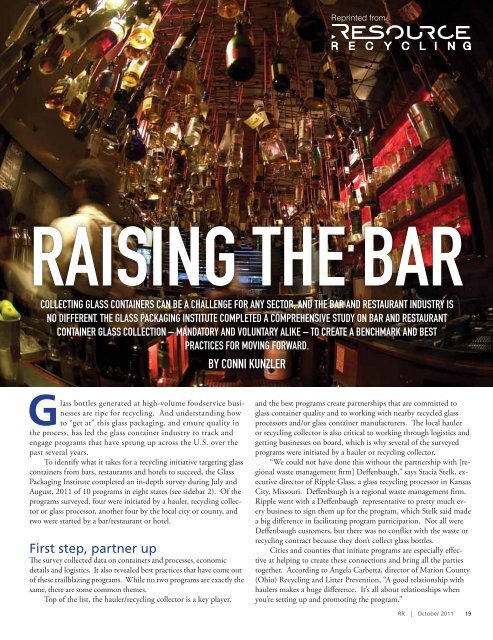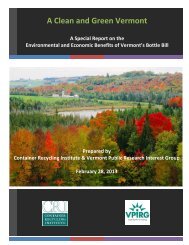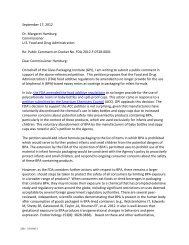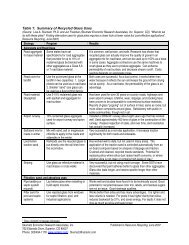First step, partner up BY CONNI KUNZLER - Glass Packaging Institute
First step, partner up BY CONNI KUNZLER - Glass Packaging Institute
First step, partner up BY CONNI KUNZLER - Glass Packaging Institute
Create successful ePaper yourself
Turn your PDF publications into a flip-book with our unique Google optimized e-Paper software.
RAISING THE BAR<br />
COLLECTING GLASS CONTAINERS CAN BE A CHALLENGE FOR ANY SECTOR, AND THE BAR AND RESTAURANT INDUSTRY IS<br />
NO DIFFERENT. THE GLASS PACKAGING INSTITUTE COMPLETED A COMPREHENSIVE STUDY ON BAR AND RESTAURANT<br />
CONTAINER GLASS COLLECTION – MANDATORY AND VOLUNTARY ALIKE – TO CREATE A BENCHMARK AND BEST<br />
PRACTICES FOR MOVING FORWARD.<br />
<strong>Glass</strong> bottles generated at high-volume foodservice businesses<br />
are ripe for recycling. And understanding how<br />
to “get at” this glass packaging, and ensure quality in<br />
the process, has led the glass container industry to track and<br />
engage programs that have sprung <strong>up</strong> across the U.S. over the<br />
past several years.<br />
To identify what it takes for a recycling initiative targeting glass<br />
containers from bars, restaurants and hotels to succeed, the <strong>Glass</strong><br />
<strong>Packaging</strong> <strong>Institute</strong> completed an in-depth survey during July and<br />
August, 2011 of 10 programs in eight states (see sidebar 2). Of the<br />
programs surveyed, four were initiated by a hauler, recycling collector<br />
or glass processor, another four by the local city or county, and<br />
two were started by a bar/restaurant or hotel.<br />
<strong>First</strong> <strong>step</strong>, <strong>partner</strong> <strong>up</strong><br />
The survey collected data on containers and processes, economic<br />
details and logistics. It also revealed best practices that have come out<br />
of these trailblazing programs. While no two programs are exactly the<br />
same, there are some common themes.<br />
Top of the list, the hauler/recycling collector is a key player,<br />
<strong>BY</strong> <strong>CONNI</strong> <strong>KUNZLER</strong><br />
Reprinted from<br />
and the best programs create <strong>partner</strong>ships that are committed to<br />
glass container quality and to working with nearby recycled glass<br />
processors and/or glass container manufacturers. The local hauler<br />
or recycling collector is also critical to working through logistics and<br />
getting businesses on board, which is why several of the surveyed<br />
programs were initiated by a hauler or recycling collector.<br />
“We could not have done this without the <strong>partner</strong>ship with [regional<br />
waste management firm] Deffenbaugh,” says Stacia Stelk, executive<br />
director of Ripple <strong>Glass</strong>, a glass recycling processor in Kansas<br />
City, Missouri. Deffenbaugh is a regional waste management firm.<br />
Ripple went with a Deffenbaugh representative to pretty much every<br />
business to sign them <strong>up</strong> for the program, which Stelk said made<br />
a big difference in facilitating program participation. Not all were<br />
Deffenbaugh customers, but there was no conflict with the waste or<br />
recycling contract because they don’t collect glass bottles.<br />
Cities and counties that initiate programs are especially effective<br />
at helping to create these connections and bring all the parties<br />
together. According to Angela Carbetta, director of Marion County<br />
(Ohio) Recycling and Litter Prevention, “A good relationship with<br />
haulers makes a huge difference. It’s all about relationships when<br />
you’re setting <strong>up</strong> and promoting the program.”<br />
RR | October 2011 19
Sidebar 1: Best practices<br />
Build <strong>partner</strong>ships that utilize and<br />
advance the local economy. The<br />
food service businesses, hauler<br />
or recycler, and glass processor<br />
working in tandem ensure that the<br />
recycled glass is returned to a glass<br />
container manufacturer for closedloop<br />
recycling. Cities and counties<br />
can be adept at helping to create<br />
these connections and bring all the<br />
parties together.<br />
Ensure sufficient participants<br />
for economic feasibility. There<br />
need to be sufficient participants<br />
to a fill a collection vehicle on a<br />
daily route to establish economic<br />
feasibility. This is a useful guide<br />
for determining the number of<br />
businesses that would be required<br />
to establish a viable program.<br />
Don’t underestimate “set <strong>up</strong>”<br />
time and personnel requirements.<br />
There is an initial requirement<br />
of personnel time to work with<br />
each business and set <strong>up</strong> the<br />
program, including assistance<br />
And in Cincinnati, Hamilton County<br />
<strong>partner</strong>ed with local waste/recycling companies,<br />
allowing businesses to reduce trash<br />
collection while adding recycling services.<br />
Getting started<br />
The majority of programs began within the<br />
past six years, and several within the past<br />
two years. Of the ten programs surveyed, on<br />
average, they have been in operation just over<br />
four years. The longest is 19 years old and the<br />
shortest has been in operation eight months.<br />
Taking out the program in existence for 19<br />
years, the outlier, the average length of time in<br />
operation is 2.75 years.<br />
Most programs were initiated to handle<br />
the volume of glass generated at bars, restaurants<br />
and hotels, as well as the environmental<br />
impact of recycling glass versus including<br />
it with the trash. According to Holly<br />
Christmann, Solid Waste Program Manager,<br />
Hamilton, Ohio, “We were getting more<br />
calls from bars and restaurants for assistance<br />
with glass recycling and realized we hadn’t<br />
addressed this sector and could get a lot<br />
of glass – and cardboard – if we provided<br />
assistance.”<br />
20 RR | October 2011<br />
with containers, logistics, training,<br />
signage, contracts, etc.<br />
Consider separate glass collection<br />
for a closed-loop end market.<br />
Separated glass collection is optimal<br />
to ensure recycled glass is used to<br />
make new glass container. While<br />
some single streams MRFs can<br />
produce sufficient quality recycled<br />
glass to be taken to a cullet<br />
processor and eventually a closedloop<br />
glass market, this results in<br />
glass loss. Single stream collection<br />
also requires processing both at a<br />
MRF and a cullet processor, which<br />
adds costs.<br />
At a minimum ensure cost neutral<br />
economics. Economics must<br />
allow for the collection of glass<br />
containers to be cost neutral,<br />
or lower, to the participating<br />
businesses. The hauler also will<br />
expect to net some profit or at<br />
minimum not incur additional costs.<br />
Work with a collection team<br />
In some cases it was motivated by generating<br />
a higher quality and volume of recycled<br />
glass for a targeted end market. “Be<br />
creative and customize your own program,”<br />
says Brad Tomm, sustainability manager<br />
for MGM Resorts International. At the 10<br />
MGM hotels in Las Vegas, they have the<br />
space and resources to sort recyclables on<br />
site, and then they sought out a recycled<br />
glass processor with an end market that<br />
returns the glass to new bottles.<br />
Rounding <strong>up</strong><br />
participants is a<br />
hands-on job<br />
Surveyed programs indicated that there was<br />
an initial requirement of personnel time<br />
to work with each business and set <strong>up</strong> the<br />
program. This primarily involved assistance<br />
with recycling containers, logistics, training,<br />
signage, contracts, etc. This is another vital<br />
element of a successful program.<br />
On average, 100 bars, restaurants<br />
and hotels participate in each surveyed<br />
programs. The smallest program has 10<br />
participating businesses and the largest<br />
committed to glass quality. The<br />
hauler/recycling collector is a<br />
key <strong>partner</strong>. Work with a hauler<br />
or recycler that is committed to<br />
glass quality and is working with<br />
a closed-loop end market for the<br />
recycled glass containers. The<br />
hauler or recycler is also critical<br />
to working through logistics and<br />
economics.<br />
Match storage containers,<br />
collection vehicles, and participants.<br />
Pay attention to outside storage<br />
space and collection vehicle<br />
accessibility. Inside, it’s more<br />
musical bins.<br />
Keep inside collection containers<br />
adaptable and clearly marked.<br />
Nearly all bars and restaurants<br />
use Slim Jims (no wheels and<br />
23 gallon) or similar, like Brute<br />
(wheeled and 50 gallon) for inside/<br />
behind bar collection. Consider<br />
signage (English and Spanish) and<br />
color of containers to help with<br />
contamination.<br />
has 330. One program includes 10 large<br />
hotels. Of those reporting, on average, each<br />
business is generating about one ton per<br />
month of mixed glass containers. Of the 10<br />
hotels participating, on average they each<br />
generate 40 tons per month (between 20-70<br />
monthly).<br />
The average amount of glass collected<br />
through a bar, restaurant and hotel recycling<br />
program is about 150 tons per month. The<br />
smallest surveyed program collects just over<br />
eight tons per month of recyclable mixed<br />
glass and the largest two citywide programs<br />
generate 400 tons per month and 650 tons<br />
per month of mixed glass.<br />
<strong>Glass</strong> containers are being collected<br />
separately from other recyclables in six of<br />
the 10 programs, and six also collect glass<br />
via a single-stream collection system. Two<br />
programs collect glass both separated for<br />
larger generators and single-stream for<br />
smaller businesses. Single-stream means<br />
either all recyclables in one collection bin or<br />
commingled containers. Those that are collecting<br />
glass separated from other recyclables<br />
are generally bypassing the materials recovery<br />
facility (MRF) and taking glass directly<br />
to a glass recycling or cullet processor.
Sidebar 2: Surveyed programs<br />
Programs initiated by a hauler/<br />
recycling collector or glass<br />
processor:<br />
WeCanRecycle<br />
Houston, Texas<br />
www.wecanrecycle.org<br />
Blue Skies Recycling<br />
St. Louis, Missouri<br />
www.blueskiesrecycling.com<br />
Dahl Recycling<br />
Colorado Springs, Colorado<br />
Ripple <strong>Glass</strong> + Deffenbaugh<br />
Industries<br />
Kansas City, Missouri<br />
www.rippleglasskc.com<br />
www.deffenbaughindustries.com<br />
Aim for cost neutral<br />
Overall, implementing glass recycling resulted<br />
in a cost-neutral scenario for businesses or a<br />
small reduction or increase in costs. Surveyed<br />
programs report that most businesses are<br />
unwilling to pay an additional fee for glass<br />
recycling collection services. Of those programs<br />
initiated by a hauler or recycling firm,<br />
all either pick <strong>up</strong> at no charge, or at a fee that<br />
allows for an overall cost neutral position for<br />
participating businesses. Some haulers also<br />
s<strong>up</strong>ply outside collection containers as part of<br />
the service.<br />
Of the surveyed programs initiated by<br />
a hauler or recycling collector, all report that<br />
the program was “economically feasible.”<br />
Andy Barton, vice president of sales for Deffenbaugh<br />
Industries stated that it was “cost<br />
neutral,” but they were getting benefits for<br />
participating in a program that is a source<br />
of pride for the community as all program<br />
<strong>partner</strong>s are part of the local economy –<br />
from brewery to recycling firm and back to<br />
glass bottles again. Indeed, the Ripple <strong>Glass</strong><br />
program in Kansas City has the ultimate<br />
closed-loop system. It has energized the local<br />
economy and is now spreading to collect<br />
recyclable glass in a dozen other cities in five<br />
nearby states.<br />
In most cases, separate glass collection<br />
requires an additional pick-<strong>up</strong>, and while<br />
glass taken out of the trash often eliminates<br />
one trash pick<strong>up</strong> each week for a business,<br />
this may not be reflected in overall economics.<br />
Terms of the existing hauling contract<br />
Local government-initiated<br />
program:<br />
Marion County Recycling and<br />
Litter Prevention<br />
Marion, Ohio<br />
www.co.marion.oh.us<br />
Hamilton County Solid Waste<br />
District<br />
Cincinnati, Ohio<br />
www.hamitoncountyrecycles.org<br />
San Luis Obispo County Integrated<br />
Waste Management Authority<br />
San Luis Obispo, California<br />
www.iwma.com<br />
may not allow for a change in volume of<br />
trash to be reflected in lower costs, although<br />
that may occur over time as contracts come<br />
<strong>up</strong> for renewal.<br />
“We’ve done some case studies where<br />
we’ve proven that at a minimum with glass<br />
and organics out of the mix, you eliminate<br />
one pick <strong>up</strong> of trash per week,” says Harry<br />
Cohen, president of Blue Skies Recycling,<br />
St. Louis, Missouri. “But, the customer<br />
has to make that change with the hauler in<br />
terms of contract, so they may be paying<br />
more until this benefit is realized.”<br />
This is echoed by Blair Pollock, solid<br />
waste planner for Orange County (North<br />
Carolina) Solid Waste Management Department,<br />
“Many bars and restaurants want<br />
to recycle but perceive it as solely a new<br />
cost,” he says. “And they may not be aware<br />
enough of their contract terms or are too<br />
locked in contractually to negotiate with<br />
their garbage hauler when they take glass<br />
bottles out of the Dumpster.”<br />
In North Carolina, glass container<br />
recycling is required by law for all outlets<br />
selling alcoholic beverages, which has given<br />
a boost to small- and medium-sized recycling<br />
collectors.<br />
Collection containers,<br />
vehicles and routes<br />
Over half of those surveyed (six) used public<br />
(state or county) and/or private grants to<br />
provide indoor and/or outdoor collection<br />
Programs initiated by a bar,<br />
restaurant, hotel or other private<br />
business:<br />
MGM Resorts<br />
Las Vegas, Nevada<br />
www.mgmresorts.com<br />
Broad Ripple Village/Union<br />
Jack Pub<br />
Indianapolis, Indiana<br />
www.greenbroadripple.org<br />
Orange County Solid Waste<br />
Management Department<br />
Chapel Hill, North Carolina<br />
www.co.orange.nc.us<br />
containers to businesses at the start of the<br />
program. “One obstacle can be the purchase<br />
of inside and outside containers,” says<br />
Carbetta. “Using a grant to assist with this<br />
helped businesses participate who didn’t want<br />
to make that investment.” For inside collection,<br />
this means predominantly Slim Jim-style<br />
containers and 96-gallon lidded roll-carts for<br />
outside collection/storage.<br />
Most collect glass containers once per<br />
week. The cost per month for each business<br />
ranges from no charge, to $25 for once per<br />
week collection of a 96-gallon tote to $125<br />
for more pick<strong>up</strong>s per week and/or larger<br />
or more containers. On average, once per<br />
week collection is about $40-$50 per month<br />
for each business. Prices vary based on size<br />
of collection container, number of containers<br />
and frequency of pick<strong>up</strong>.<br />
Six surveyed programs use 96-gallon<br />
containers for final collection. These are<br />
loaded on to a collection vehicle using an<br />
automated arm/tipper; two haulers surveyed<br />
use automated lift gates to load 96-gallon<br />
containers onto 24-foot box trucks. Another<br />
three programs (two single-stream and<br />
one glass separated) use between 2-yard and<br />
8-yard containers and front- or rear-loading<br />
collection vehicles. In the case of highergenerating<br />
customers, glass is collected and<br />
hauled in a roll-off container.<br />
Typically a collection vehicle is used<br />
one day/week for a glass container collection<br />
route. There needs to be sufficient customers<br />
to a fill the collection vehicle on a daily<br />
RR | October 2011 21
oute to establish economic feasibility. One<br />
survey respondent stated that the minimum<br />
threshold for a once per week glass collection<br />
route is between 50 and 75 participating<br />
businesses within a designated area.<br />
This, however, varies for each program and<br />
the volume of glass containers generated at<br />
each business.<br />
There can be challenges with outside<br />
storage space and enclosure limitations. “A<br />
lot of these streets and structures were not<br />
built for recycling,” says Barton. “So getting<br />
a truck in and out of alleys and other dense<br />
areas can create a space problem.” It’s also<br />
necessary to work with property managers.<br />
A property manager may not want to<br />
participate even though the leasing business<br />
does. This adds another layer to issues of<br />
participation and access to outside recycling<br />
storage locations.<br />
Target a closed-loop<br />
end market<br />
In all programs surveyed, the collected glass<br />
containers are used in the manufacture of<br />
22 RR | October 2011<br />
new glass bottles and jars or to make fiberglass<br />
insultation. This is largely because the<br />
glass bottles are being collected separated<br />
from other recyclables (six programs), thus<br />
bypassing the MRF and going directly to a<br />
cullet processor.<br />
Recycled glass bottles collected single<br />
stream are taken first to a MRF (six programs)<br />
and then to the cullet processor.<br />
There is no data in this survey on recycled<br />
glass loss through this process, although a<br />
2009 Container Recycling <strong>Institute</strong> study<br />
found that for single-stream curbside collection,<br />
40 percent of glass gets recycled<br />
into new glass containers, on average, and<br />
another 40 percent ends <strong>up</strong> in landfills;<br />
the remaining 20 percent is presumably<br />
going to a secondary use.<br />
“Make sure recycling facilities can<br />
manage the flow of materials. While<br />
it’s easy to collect glass containers, the<br />
biggest issue is at the MRF to make glass<br />
a viable product,” says Bill Worrell from<br />
the San Luis Obispo County (California)<br />
Integrated Waste Management Authority.<br />
“MRFs are set <strong>up</strong> so that it goes through<br />
a series of screens, and while we’re able to<br />
create a viable glass products for making<br />
new glass bottles with very little going to<br />
landfill, not all MRFs can.” In California,<br />
the state’s beverage container redemption<br />
program provides an incentive to recycle<br />
glass.<br />
As the glass container industry pushes<br />
forward to increase the amount of recycled<br />
glass it uses to make new glass bottles<br />
and jars, it’s clear that bar, restaurant and<br />
hotel programs have an important role.<br />
Both the volume and quality of recycled<br />
glass coming out of these programs is<br />
significant. To make this happen, glass<br />
container manufacturers will need to<br />
continue efforts to <strong>step</strong> <strong>up</strong> outreach and<br />
<strong>partner</strong> with recycling collectors, communities<br />
and other local resources to<br />
stimulate more foodservice glass recycling<br />
programs.<br />
Reprinted with permission from Resource<br />
Recycling, P.O. Box 42270, Portland, OR<br />
97242-0270; (503) 233-1305, (503) 233-<br />
1356 (fax); www.resource-recycling.com.






